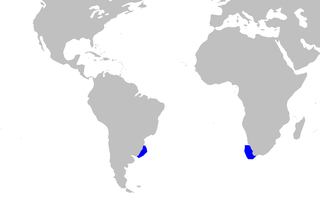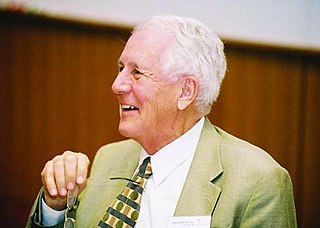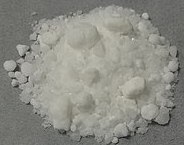
Luminescence is a spontaneous emission of radiation from an electronically or vibrationally excited species not in thermal equilibrium with its environment. A luminescent object emits cold light in contrast to incandescence, where an object only emits light after heating. Generally, the emission of light is due to the movement of electrons between different energy levels within an atom after excitation by external factors. However, the exact mechanism of light emission in vibrationally excited species is unknown.

Tentaculata is a class of comb jellies, one of two classes in the phylum Ctenophora. The common feature of this class is a pair of long, feathery, contractile tentacles, which can be retracted into specialised ciliated sheaths. In some species, the primary tentacles are reduced and they have smaller, secondary tentacles. The tentacles have colloblasts, which are sticky-tipped cells that trap small prey.

The beetle family Phengodidae is known also as glowworm beetles, whose larvae are known as glowworms. The females and larvae have bioluminescent organs. They occur throughout the New World from extreme southern Canada to Chile, numbering over 250 species in total. The recently recognized members of the Phengodidae, the Cydistinae, are found in Western Asia. The family Rhagophthalmidae, an Old World group, used to be included in the Phengodidae.

Stokes shift is the difference between positions of the band maxima of the absorption and emission spectra of the same electronic transition. It is named after Irish physicist George Gabriel Stokes.

1,10-Phenanthroline (phen) is a heterocyclic organic compound. It is a white solid that is soluble in organic solvents. The 1,10 refer to the location of the nitrogen atoms that replace CH's in the hydrocarbon called phenanthrene.

In the field of cell biology, TNF-related apoptosis-inducing ligand (TRAIL), is a protein functioning as a ligand that induces the process of cell death called apoptosis.
Luminescent bacteria emit light as the result of a chemical reaction during which chemical energy is converted to light energy. Luminescent bacteria exist as symbiotic organisms carried within a larger organism, such as many deep sea organisms, including the Lantern Fish, the Angler fish, certain jellyfish, certain clams and the Gulper eel. The light is generated by an enzyme-catalyzed chemoluminescence reaction, wherein the pigment luciferin is oxidised by the enzyme luciferase. The expression of genes related to bioluminescence is controlled by an operon called the lux operon.

The taillight shark is a little-known species of shark in the family Dalatiidae and the only member of its genus. It is known from only four specimens collected from deep oceanic waters in the southern Atlantic Ocean and Pacific Ocean. A small shark with a laterally compressed body and a bulbous snout, this species has unusual adaptations that indicate a specialized lifestyle: its pectoral fins are paddle-like and may be used for propulsion, unlike other sharks and it has a pouch-like gland on its abdomen that emits clouds of luminescent blue fluid. This shark is likely aplacental viviparous and a formidable predator for its size.

Tris(8-hydroxyquinolinato)aluminium is the chemical compound with the formula Al(C9H6NO)3. Widely abbreviated Alq3, it is a coordination complex wherein aluminium is bonded in a bidentate manner to the conjugate base of three 8-hydroxyquinoline ligands.

Electrochemiluminescence or electrogenerated chemiluminescence (ECL) is a kind of luminescence produced during electrochemical reactions in solutions. In electrogenerated chemiluminescence, electrochemically generated intermediates undergo a highly exergonic reaction to produce an electronically excited state that then emits light upon relaxation to a lower-level state. This wavelength of the emitted photon of light corresponds to the energy gap between these two states. ECL excitation can be caused by energetic electron transfer (redox) reactions of electrogenerated species. Such luminescence excitation is a form of chemiluminescence where one/all reactants are produced electrochemically on the electrodes.

Coelenterazine is a luciferin, a molecule that emits light after reaction with oxygen, found in many aquatic organisms across eight phyla. It is the substrate of many luciferases such as Renilla reniformis luciferase (Rluc), Gaussia luciferase (Gluc), and photoproteins, including aequorin, and obelin. All these proteins catalyze the oxidation of this substance, a reaction catalogued EC 1.13.12.5.

Panellus stipticus, commonly known as the bitter oyster, the astringent panus, the luminescent panellus, or the stiptic fungus, is a species of fungus. It belongs in the family Mycenaceae, and the type species of the genus Panellus. A common and widely distributed species, it is found in Asia, Australia, Europe, and North America, where it grows in groups or dense overlapping clusters on the logs, stumps, and trunks of deciduous trees, especially beech, oak, and birch. During the development of the fruit bodies, the mushrooms start out as tiny white knobs, which, over a period of one to three months, develop into fan- or kidney-shaped caps that measure up to 3 cm (1.2 in) broad. The caps are orange-yellow to brownish, and attached to the decaying wood by short stubby stalks that are connected off-center or on the side of the caps. The fungus was given its current scientific name in 1879, but has been known by many names since French mycologist Jean Bulliard first described it as Agaricus stypticus in 1783. Molecular phylogenetic analysis revealed P. stipticus to have a close genetic relationship with members of the genus Mycena.

John Woodland "Woody" Hastings, was a leader in the field of photobiology, especially bioluminescence, and was one of the founders of the field of circadian biology. He was the Paul C. Mangelsdorf Professor of Natural Sciences and Professor of Molecular and Cellular Biology at Harvard University. He published over 400 papers and co-edited three books.

Polyfluorene is a polymer with formula (C13H8)n, consisting of fluorene units linked in a linear chain — specifically, at carbon atoms 2 and 7 in the standard fluorene numbering. It can also be described as a chain of benzene rings linked in para positions with an extra methylene bridge connecting every pair of rings.

A luminescent solar concentrator (LSC) is a device for concentrating radiation, solar radiation in particular, to produce electricity. Luminescent solar concentrators operate on the principle of collecting radiation over a large area, converting it by luminescence and directing the generated radiation into relatively small photovoltaic solar cells at the edges.

Carolina Chocolate Drops/Luminescent Orchestrii is a collaborative EP by Durham, North Carolina-based string band Carolina Chocolate Drops and experimental music band Luminescent Orchestrii. It was released on January 25, 2011 on Nonesuch Records.
Europium(III) fluoride is an inorganic compound with a chemical formula EuF3.

Jason Birch is a scholar of medieval haṭha yoga and a founding member of SOAS's Centre for Yoga Studies. His research includes locating and translating early yoga manuscripts, and preparing critical editions, such as of the Amaraugha.

Ytterbium(III) acetate is an inorganic salt of ytterbium and acetic acid, with a chemical formula of Yb(CH3COO)3. It has colorless crystals that are soluble in water and can form hydrates.

Lutetium(III) acetate is the acetate salt of lutetium with the chemical formula of Lu(CH3COO)3.


















